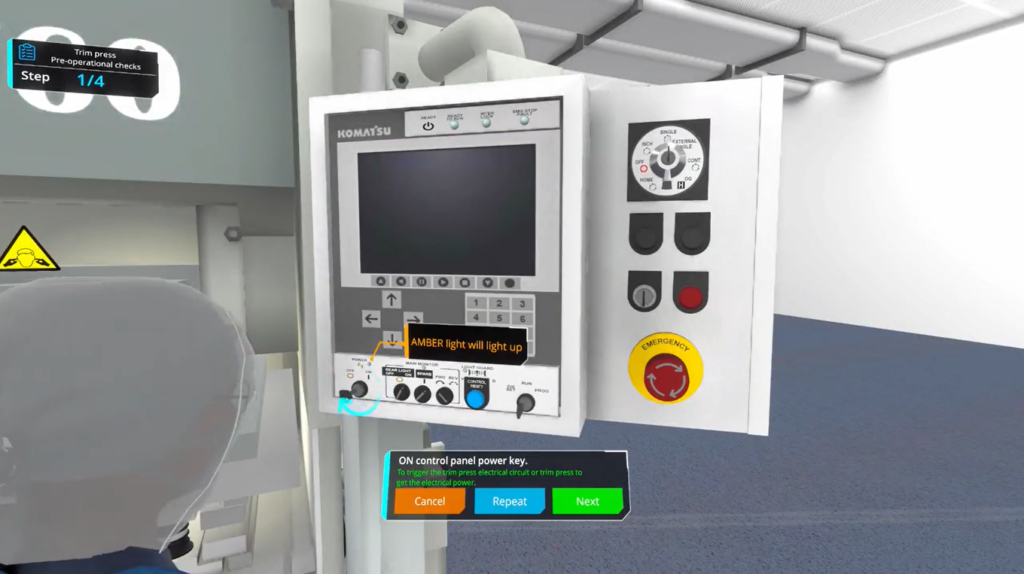In today’s fast-paced industrial landscape, efficient training methods are essential for businesses that work with heavy machinery or precision equipment. Traditional training methods can be time-consuming, costly, and sometimes even hazardous. Virtual Reality has emerged as a transformative technology, offering a safe, effective, and immersive training environment that replicates real-world scenarios, making it ideal for skill-building on complex equipment
Why VR for Training on Heavy / Precision Equipment?
Training on heavy machinery or delicate equipment requires careful handling, a deep understanding of machine operations, and an emphasis on safety protocols. VR offers a solution by providing a realistic simulation environment that allows employees to familiarize themselves with equipment operation, procedures, and emergency scenarios without the risk of injury or damage. Here are some of the key benefits VR offers in this field:
Virtual Reality (VR) offers a safer, more cost-effective way to train employees on heavy and precision equipment by providing a controlled environment that mitigates risks. In a VR setting, new trainees can familiarize themselves with complex machinery without exposure to real-world hazards, enhancing safety across the board. VR also enables significant cost savings by reducing the need for physical setups, supervision, and potential downtime of actual equipment. Additionally, companies save on expenses related to accidents, equipment damage, and errors from inexperienced operators.
Beyond safety and savings, VR enhances learning speed and retention by immersing trainees in hands-on scenarios that foster deeper understanding. Employees can repeatedly practice equipment operation, mastering functions at their own pace. VR training also breaks down geographical and logistical barriers, allowing consistent training experiences across different locations, even reaching remote employees. This immersive setup enables trainees to practice realistic scenarios—such as adverse weather or equipment malfunctions—preparing them for real-world challenges in a safe, controlled environment.

Applications of VR in Heavy / Precision Equipment Training
1. Construction and Heavy Machinery Training: Construction sites are often dynamic, busy, and filled with potential hazards. VR-based training programs can replicate this environment, teaching employees to handle equipment like cranes, excavators, and bulldozers without any real-world risk. Trainees can practice operating equipment under various conditions, including high-traffic zones and challenging weather, which are otherwise difficult to simulate safely.
2. Manufacturing and Industrial Equipment Training: Manufacturing companies operate complex machinery that requires specific skills and knowledge. VR simulations can recreate industrial equipment operations, teaching trainees how to manage tasks like assembly line operations, safety protocols, and emergency shutdowns. This reduces the likelihood of mistakes and accidents on the production floor.
3. Aerospace and Automotive Maintenance Training: In the aerospace and automotive sectors, precision is critical. VR can recreate the exact environment of a workshop or hangar, allowing technicians to familiarize themselves with tools and workflows involved in the maintenance and repair of aircraft and vehicles. This level of immersive training is crucial in sectors where precision and accuracy are paramount.
4. Healthcare and Laboratory Equipment Training: Healthcare professionals increasingly rely on complex equipment for diagnostics and treatment. VR training programs allow medical professionals to practice operating this equipment and handle delicate tasks, such as surgery or lab testing, without risking patient safety or equipment damage.
Key Technologies and Tools in VR Training
The development of VR for training heavy and precision equipment involves several technologies, each playing a crucial role in creating an immersive and interactive experience:
- Motion Tracking Sensors – Track the trainee’s movements to provide accurate, real-time responses in the virtual environment.
- Haptic Feedback Devices – Offer tactile feedback that mimics the feel of handling machinery or tools, adding a layer of realism.
- 3D Modelling Software – Creates realistic, high-fidelity models of the equipment, ensuring that VR simulations are as close to real-life as possible.
- AI-Driven Scenarios – Allows VR training to simulate unpredictable situations, ensuring trainees are prepared for various challenges and emergencies.
Future of VR in Equipment Training
The future of VR training holds immense potential as advancements in VR hardware and software continue. In addition, with AI-powered adaptive learning, VR systems could adjust training scenarios based on the trainee’s progress, identifying areas where they need additional practice. This creates a truly personalized and data-driven approach to skill-building.
The integration of VR with other technologies, such as the Internet of Things (IoT), could also enable real-time data collection on equipment performance, helping companies optimize both training and equipment usage.
Closing Remarks
Virtual Reality has redefined training methodologies for industries relying on heavy and precision equipment. By providing a safe, cost-effective, and flexible alternative to traditional training methods, VR enhances employee skills while reducing risks and costs. As VR technology continues to evolve, it’s poised to become an integral part of workforce training, setting new standards for operational excellence and safety across industries.
Ready to elevate your workforce training? Embrace Virtual Reality to equip your team with the skills, confidence, and safety-first approach needed to handle heavy and precision equipment. With VR, you’re not just training employees—you’re setting a new standard in operational efficiency, safety, and cost-effectiveness. Contact us today..
